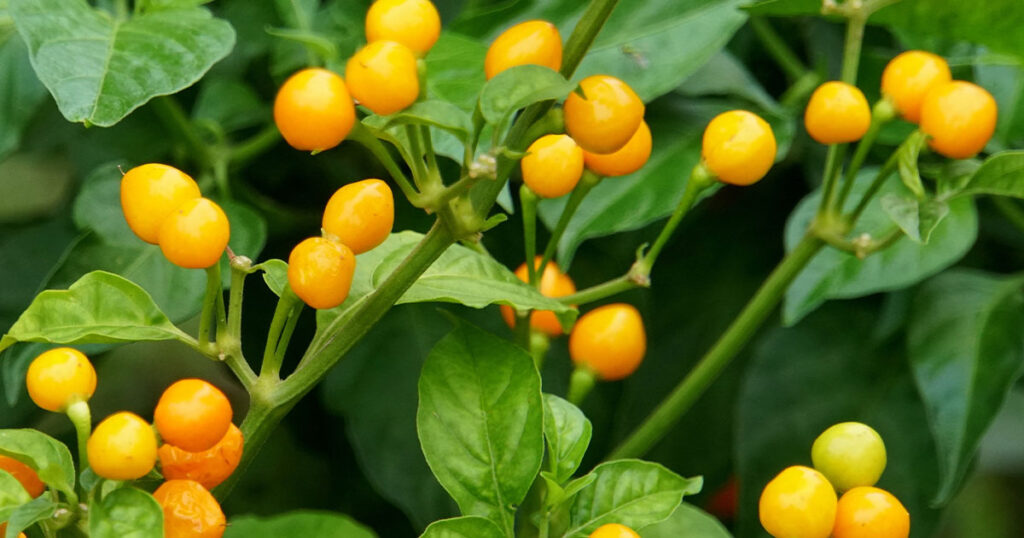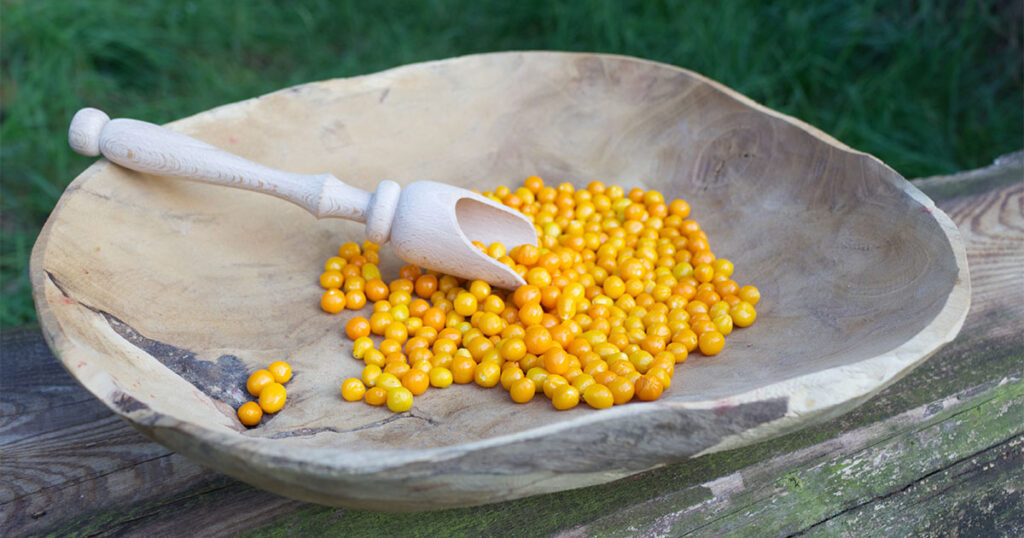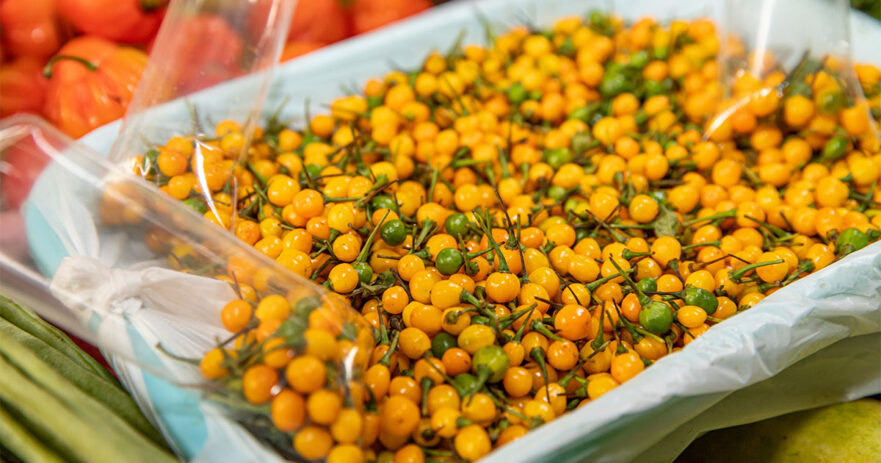In this article about aji charapita pepper:
🗺️ Origin and history | 🌶️ Uses | ✨ Appearance and taste | 🧑🌾 Growing – gardening | 👨🍳 Cooking – recipes | 🛒 Where to buy | 🫙 How to store | 👨⚕️ Health benefits | 🌶️ Alternatives and substitutes | ❓ Frequently asked questions
What is Aji charapita pepper?
The Aji charapita, recognized for its small yet mighty presence, originates from the Amazonian region of Peru. Belonging to the Capsicum chinense species, it boasts a Scoville Heat Unit (SHU) range of 30,000 to 50,000, marking it as a moderately hot pepper. The Aji charapita is renowned for its fruity, tangy, and sweet taste profile, making it an ideal choice for sauces, salsas, and seasoning in traditional Peruvian dishes. Despite its size, this pepper is a powerhouse of flavor, adding a distinct spice and aroma to culinary creations. Its culinary versatility and flavor profile make it a valuable ingredient for both home cooks and professional chefs looking to infuse their dishes with authentic Peruvian heat and flavor.
Are Aji charapita peppers spicy? How hot are they?
Aji charapita scoville: 30,000 to 50,000 SHU
With a Scoville Heat Unit (SHU) rating of 30,000 to 50,000, Aji charapita peppers fall into the moderately spicy category. This heat level is significantly above that of a bell pepper, which has no heat but below some of the world’s hottest peppers, making it accessible to a broader audience.
The mean SHU of 40,000 situates the Aji charapita well above common culinary peppers like the jalapeño, which ranges from 2,500 to 8,000 SHU, yet below the extreme heat of varieties like the habanero.
This moderate heat level, combined with its fruity, tangy, and sweet flavor profile, makes the Aji charapita a versatile pepper in the kitchen, capable of adding a distinctive spice without overwhelming the dish. Its culinary applications are broad, from enhancing sauces and salsas to being a seasoning in various dishes, offering a balance of heat and flavor that is highly sought after.
🗺️ ORIGIN AND HISTORY
Where does the Aji charapita pepper come from?
The Aji charapita originates from the Amazonian region of Peru, marking its place as a valued specimen within the Capsicum chinense species. This small but mighty pepper has been a part of Peruvian cuisine and culture for centuries, traditionally used by indigenous peoples for its culinary and medicinal properties. Its adoption into broader culinary practices has been relatively recent, with its popularity and demand surging as chefs and food enthusiasts worldwide discover its unique blend of heat and flavor.
The name ‘Aji charapita’ reflects the local heritage, with ‘Aji’ being a common term in South America for chili peppers and ‘charapita’ possibly referring to its small size or the region’s local dialect. Today, the Aji charapita is a staple in Peruvian dishes and an exotic ingredient sought after by gourmet kitchens globally, embodying the rich biodiversity of the Amazon and the depth of Peruvian agricultural heritage.
🌶️ USES
What are Aji charapita peppers good for? How to use them?
Aji charapita peppers are celebrated for their vibrant flavor and moderate heat, making them an excellent choice for various culinary uses. They’re renowned for adding a fresh, fruity kick to dishes, which pairs well with rice, fish, and chicken. The unique taste of Aji charapita also shines in salsas and hot sauces, where its fruity undertones can complement tropical fruits beautifully.
These peppers are versatile in preparation methods, including fresh to finish dishes or dried to incorporate into seasoning blends. Aji charapita can be transformed into a spicy hot pepper cheese spread, offering a delightful mix of flavors for appetizers or snacks.
Another creative use is in dips, such as a black bean charapita dip, which combines the pepper’s distinct heat with the creamy texture of beans for a refreshing and spicy treat. Incorporating Aji charapita peppers can elevate the dish with a burst of flavor and heat for those looking to add a bit of zest to their tacos.
When dried, Aji charapita peppers become an ideal seasoning option, adding depth and a fruity, flowery flavor to any meal. They are perfect for crafting your spice blends or meat rubs, thanks to their delicious flavor profile that doesn’t overpower dishes despite their heat.
This makes Aji Charapita a beloved ingredient among home cooks and professional chefs looking to fine-tune their culinary creations’ flavor and heat levels.
✨ APPEARANCE AND TASTE
What does an Aji charapita pepper look like?
The Aji charapita pepper, often resembling a wild berry more than a typical chili, is a vibrant representation of Peru’s rich biodiversity. This small yet fiery chili hails from the Amazon rainforest regions of Loreto and Ucayli, thriving in the warm, humid climate that characterizes its native habitat. The Aji charapita plants are bushy and compact, capable of producing hundreds of these tiny, yellowish-orange peppers each season, approximately the size of a pea. Their scarcity outside of South America contributes to their reputation as one of the most expensive peppers in the world. However, this claim has been debunked, with prices for dried Aji Charapitas being more accessible than initially rumored.
What does Aji charapita pepper taste like?
Taste-wise, Aji charapita peppers offer a unique, tropical fruitiness, with a sweetness and intensity comparable to the habanero but with significantly less heat, making them some of the most delicious peppers for culinary use. Despite their small size, they pack a considerable punch in terms of heat, measuring between 30,000-50,000 Scoville Heat Units (SHU), positioning them similarly to the Cayenne pepper in terms of spiciness. This combination of moderate heat with a rich flavor profile makes Aji charapita peppers a favored ingredient for salsas hot sauces and as a finishing spice to enhance the taste of dishes without overwhelming them with spiciness.
🧑🌾 GROWING – GARDENING

How to grow Aji charapita peppers?
Growing Aji charapita peppers starts with sowing seeds in well-draining soil with a pH between 6.2 and 7.0, enriched with organic matter for optimum fertility. Seeds need warmth and moisture to germinate, usually within 10-20 days, and seedlings should be transplanted once they develop several true leaves, ensuring enough space for growth. Consistent watering is crucial, but avoid overwatering to prevent root rot. Bi-weekly fertilization with a balanced, water-soluble fertilizer is recommended. Prune to encourage bushier growth and better air circulation.
When to pick Aji charapita peppers?
Aji Charapita peppers are ready to harvest when they turn bright yellow, typically 90 to 150 days post-transplanting. The correct harvesting time is critical to enjoying their full fruity and floral flavor and heat.
👨🍳 COOKING – RECIPES
Cooking / Recipe ideas for Aji charapita
The Aji Charapita pepper, celebrated for its vibrant flavor and moderate heat, lends itself to many culinary uses that highlight its unique taste profile. This Peruvian chili is a powerhouse of flavor, making it an ideal choice for sauces and salsas and as a seasoning in traditional dishes.
Preparing Aji charapita hot sauce involves blending the peppers with vinegar, garlic, and a hint of sweetness. It can elevate any dish with its fiery yet manageable heat, making every meal an adventure.
For a hot pepper cheese spread, finely chopping Aji charapita peppers and mixing them into softened cream cheese with shredded sharp cheddar offers a spicy kick ideal for crackers or vegetable sticks.
Creating a spicy black bean Charapita dip involves blending the peppers with black beans, lime juice, and spices. This results in a creamy, flavorful concoction perfect for dipping tortilla chips or as a taco filling.
Spicy Charapita fish tacos benefit from a marinade of lime juice, olive oil, and minced Aji charapita peppers, providing a delicious heat that complements the freshness of the fish. An Argentinian-inspired flank steak gains depth and zest from an Aji charapita chimichurri, where the peppers are combined with parsley, garlic, olive oil, and vinegar, offering a perfect topping for grilled meats.
Lastly, Aji charapita pepper jelly, combining the peppers with sugar, vinegar, and pectin, creates a sweet and spicy spread that pairs wonderfully with cheeses and cured meats, showcasing the unique flavor profile of the Aji charapita in a versatile and gift-worthy format.
These recipes demonstrate the Aji charapita’s culinary flexibility and role in enriching dishes with authentic Peruvian heat and flavor, making it a beloved ingredient among home cooks and professional chefs. Whether used fresh to finish dishes or dried to incorporate into seasoning blends, the Aji charapita offers a balance of heat and flavor that is highly sought after in the culinary world.
🛒 WHERE TO BUY
Where can I buy Aji charapita peppers?
Aji charapita peppers, native to the Peruvian Amazon, are renowned not only for their taste but also for their rarity outside of South America, which can make them a bit of a treasure hunt to acquire. Specialty grocers or international markets focusing on Peruvian or South American foods may stock them. Online platforms may also offer fresh Aji charapita peppers, providing a convenient way to purchase them from anywhere. Additionally, you can buy a range of Aji charapita products, from dried peppers to hot sauces and chutneys, catering to gourmet chefs and enthusiasts worldwide.
Where can I buy Aji charapita pepper plants?
For those interested in growing Aji charapita peppers, plants can occasionally be found at nurseries or garden centers focusing on exotic or specialty vegetables. Additionally, online gardening stores and platforms advertise live Aji charapita plants, often accompanied by care instructions to ensure successful cultivation.
Where can I buy Aji charapita pepper seeds?
If you want to grow Aji charapita pepper from the start, seeds are available through various online seed retailers, gardening stores, and specialized pepper websites. These seeds can be planted in well-draining soil and require a warm, humid environment to thrive, similar to their native Amazonian habitat. Gardening guides and tips can help you start your Aji charapita garden and ensure a successful growth season.
🫙 HOW TO STORE

How do I store Aji charapita pepper?
To store Aji charapita peppers, you can keep the freshly picked ones in the refrigerator for up to one week. For longer storage, air-dry them at room temperature until they shrivel into a raisin-like texture, then store them in an airtight container away from direct sunlight and moisture. This method allows dried Charapitas to last many months without losing heat or flavor.
Can Aji charapita peppers be frozen?
Yes, freezing Aji charapita peppers is a good option for long-term storage. To freeze them, wash the peppers thoroughly, then dry them completely to prevent ice crystal formation. Place the peppers in a single layer on a baking sheet to freeze individually, then transfer them into airtight containers or freezer bags. This method helps preserve their flavor and heat, allowing them to be used for up to six months.
❤️🩹 HEALTH BENEFITS
Are Aji charapita peppers healthy?
Aji charapita peppers are not just known for their unique flavor and heat but also for their health benefits. They are rich in vitamins, particularly vitamin C, and contain capsaicin, known for its metabolism-boosting and anti-inflammatory properties. This makes Aji charapita a beneficial addition to a balanced diet.
It’s important to note that some individuals might experience gastrointestinal discomfort after consuming spicy foods. This reaction can occur even with peppers that are only mildly spicy. If consuming Aji charapita peppers or any spicy food leads to discomfort, it may be advisable to reduce the amount consumed or avoid them altogether to prevent adverse reactions.
🔄 ALTERNATIVES AND SUBSTITUTES
What’s a suitable alternative to Aji charapita pepper?
To find an alternative to the Aji charapita pepper, we should consider peppers with a balance of heat and flavor.
While Scotch Bonnet or Habanero peppers offer a similar fruity and spicy profile, their heat levels (100,000 – 350,000 SHU) significantly surpass Aji charapita’s 30,000 to 50,000 SHU, making them less comparable in terms of heat.
A more suitable alternative might be the Calabrian pepper, with a SHU range of 25,000 to 40,000, which offers a sweet, fruity, smoky, and slightly salty flavor, closely matching Aji charapita’s profile.
The Chiltepin pepper, with its SHU of 50,000 – 100,000, not only provides a heat level closer to Aji charapita but also bears a striking resemblance in appearance, making it a visually and gastronomically fitting substitute. It can be a good substitute for adding a spicy kick with a distinct flavor to dishes.
How do you pronounce Aji charapita peppers?
The Aji charapita peppers are pronounced as AH-hee chah-rah-PEE-tah PEP-erz.
🙋 FREQUENTLY ASKED QUESTIONS
FAQ about Aji charapita peppers
How hot are Aji charapita peppers?
Aji charapita peppers boast a Scoville Heat Unit (SHU) range of 30,000 to 50,000, placing them in the moderately hot category of chili peppers. This level of spiciness situates them significantly above the heat level of common culinary peppers like the jalapeño, which ranges from 2,500 to 8,000 SHU, but well below some of the world's fiercest contenders like the habanero. The Aji charapita's heat is unique because it delivers a vibrant burst of spiciness that challenges the palate and enhances the dishes' flavors. Their moderate heat makes them a versatile ingredient, perfect for adding a distinct spicy kick to various dishes without overwhelming other flavors. This blend of moderate heat with a rich, fruity, and tangy flavor profile makes Aji charapita peppers a sought-after ingredient for traditional Peruvian recipes and innovative culinary experiments worldwide.
Why is Aji charapita expensive?
The Aji charapita pepper's reputation as one of the most expensive peppers in the world can be attributed to several factors. Firstly, its origin in Peru's Amazonian region means it's not widely cultivated globally, limiting its availability outside of South America. Additionally, the Aji charapita is a wild pepper, making its cultivation and harvest more labor-intensive than other domesticated varieties. The small size of the peppers further contributes to the labor costs, as a significant quantity is needed to produce a viable crop. Moreover, its unique flavor profile and moderate heat level have created a high demand among gourmet chefs and culinary enthusiasts seeking authentic Peruvian ingredients. The combination of limited supply, high demand, and labor-intensive harvesting processes drives up the cost, making the Aji charapita a premium pepper in the culinary world. Despite its high price, the distinct taste and versatility of the Aji charapita continue to make it a coveted ingredient for those looking to add a touch of Peruvian heat and flavor to their dishes.
